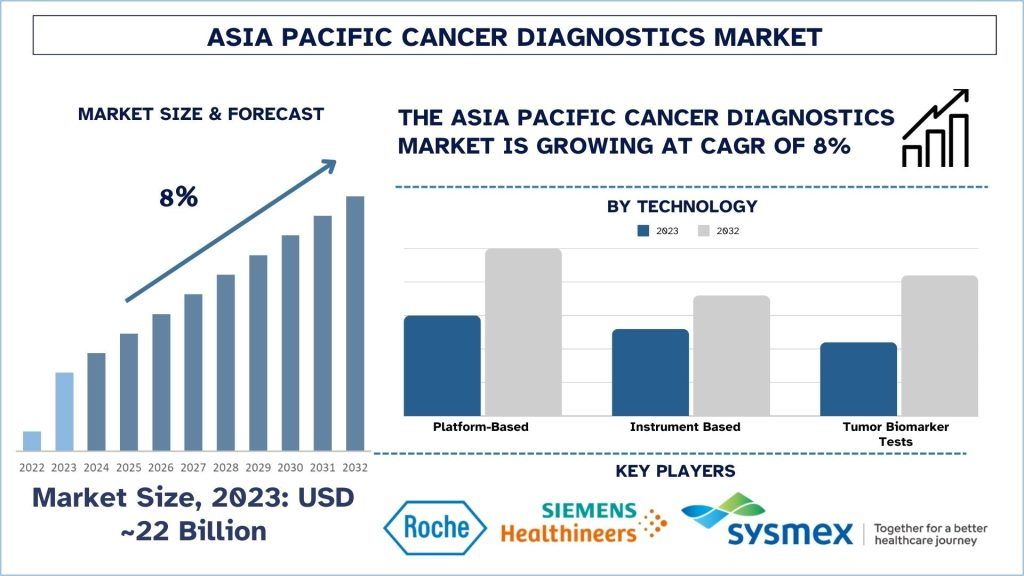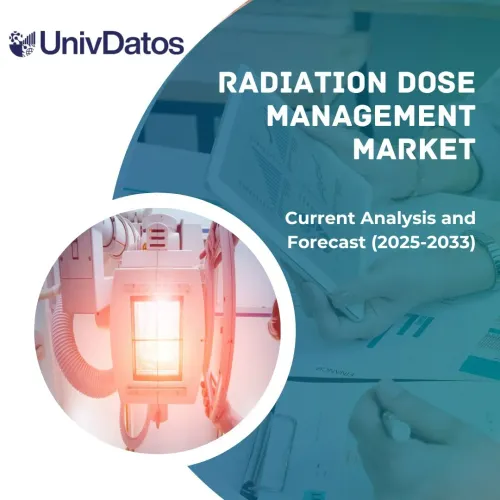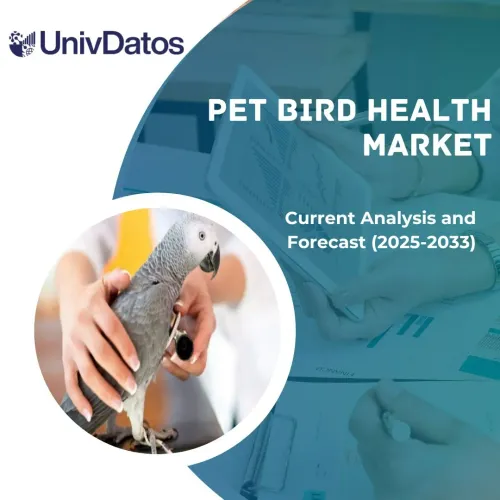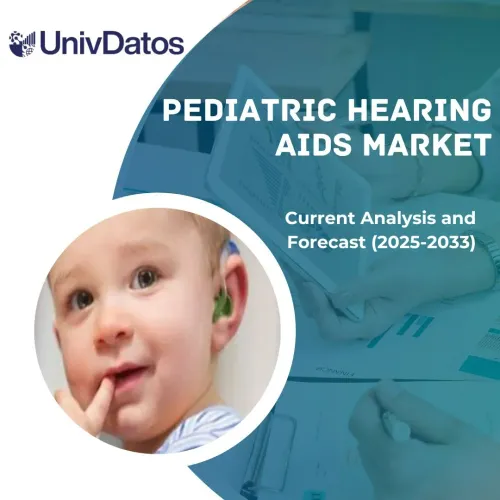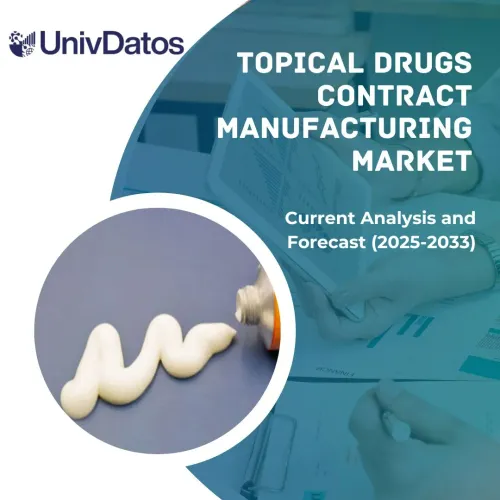- Startseite
- Über uns
- Industrie
- Dienstleistungen
- Lesen
- Kontaktieren Sie uns
Asien-Pazifik-Markt für Krebsdiagnostik: Aktuelle Analyse und Prognose (2024-2032)
Schwerpunkt auf Anwendung (Blutkrebs, Lungenkrebs, Darmkrebs, Prostatakrebs, Brustkrebs, Gebärmutterhalskrebs, andere); Diagnosetyp (Labortests, Gentests, Bildgebungstests, Biomarker-Tests, In-vitro-Diagnostiktests, Biopsie, Sonstige); Technologie (Plattformbasiert, Instrumentenbasiert, Tumor-Biomarker-Tests); Endverbraucher (Krankenhäuser, Krebsforschungsinstitute, Diagnostische Labore, Sonstige) und Land
Asien-Pazifik Marktgröße & Prognose für Krebsdiagnostik
Der Asien-Pazifik-Markt für Krebsdiagnostik wurde im Jahr 2023 auf etwa 22 Milliarden USD geschätzt und wird im Prognosezeitraum (2024-2032) aufgrund der wachsenden Krebsprävalenz in Asien voraussichtlich mit einer robusten CAGR von rund 8 % wachsen.
Asien-Pazifik Marktanalyse für Krebsdiagnostik
Der Markt für Krebsdiagnostik im asiatisch-pazifischen Raum verzeichnet ein signifikantes Wachstum aufgrund des Anstiegs der Anzahl von Empfehlungen für Krebs-Screenings wie Blutkrebs, Lungenkrebs, Darmkrebs, Prostatakrebs, Brustkrebs, Gebärmutterhalskrebs und andere, die die Diagnose von Krebsdiagnostika im asiatisch-pazifischen Raum erhöht haben. Große Gesundheitsunternehmen investieren aufgrund des steigenden sozialen Bewusstseins für Krebs stark in ihre Produkte.Beispielsweise entwickelt und vermarktet INOVIQ Limited im September 2022 Exosomen-Capture-Tools der nächsten Generation und Präzisionsdiagnostika, um die Diagnose und Behandlung von Krebs und anderen Krankheiten zu verbessern. Die Krebsdiagnostik-Pipeline von INOVIQ umfasst Bluttests, die zur Früherkennung und Überwachung von Eierstock-, Brust- und anderen Krebsarten entwickelt werden.Somit ermöglicht die CDx-Pan-Krebs-Indikation die Identifizierung von Krebspatienten mit mehreren Tumorgenen und Biomarkern, um das spezifische molekulare Profil des Krebs eines Patienten aufzudecken. Darüber hinaus ist die fortschrittliche Technologie, die Portabilität, die solide Tumore bewertet, die positiv für Fusionen des neurotrophen Tyrosinrezeptor-Kinase (NTRK)-Gens sind, eine wünschenswerte Wahl für Verbraucher, die Krebsdiagnosen in einer Vielzahl von diagnostischen Umgebungen durchführen möchten.
Asien-Pazifik Markttrends für Krebsdiagnostik
Dieser Abschnitt erörtert die wichtigsten Markttrends, die die Segmente des Asien-Pazifik-Marktes für Krebsdiagnostik beeinflussen, wie sie von unseren Forschungsexperten identifiziert wurden.
Krankenhäuser transformieren die Industrie
Es wird erwartet, dass Krankenhäuser im Prognosezeitraum die höchste CAGR verzeichnen werden. Eine wachsende Anzahl von Krankenhäusern aufgrund der zunehmenden Präferenz der Patienten für krankenhausbasierte Verfahren, die Verfügbarkeit von qualifiziertem Gesundheitspersonal und günstige Erstattungsszenarien tragen zum Wachstum des Segments bei. Die Vorteile, die mit dem Krankenhaus verbunden sind, wie z. B. die Verfügbarkeit genauer Diagnosen und bessere Alternativen, die die Endverbraucher eher zum Krankenhaus tendieren lassen. Die kontinuierliche Entwicklung neuer Produkte und Verfahren wird den Markt des Segments im Prognosezeitraum voraussichtlich stärken.
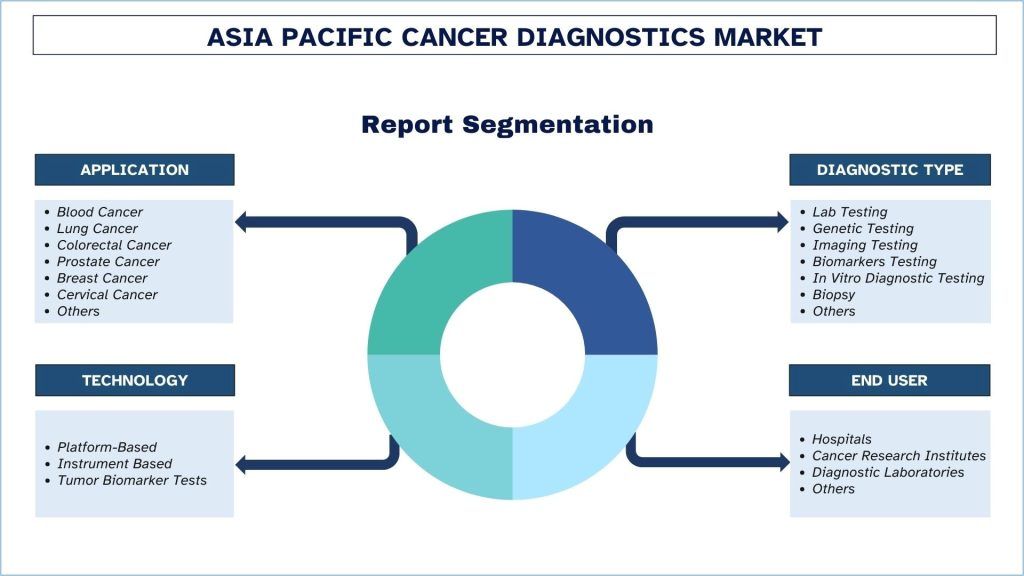
China dominierte den Markt im Jahr 2023
Es wird erwartet, dass China das höchste CAGR-Wachstum auf dem Asien-Pazifik-Markt für Krebsdiagnostik aufweisen wird. Die Zunahme der technologischen Entwicklung in Schwellenländern sowie die Expansion der Gesundheitsbranche haben zum Wachstum des chinesischen Marktes beigetragen. China hat eine höhere Akzeptanzrate von technologisch fortschrittlichen und innovativen Lösungen für die Diagnostik von Krebs. Das verbesserte Krebsbewusstsein hinsichtlich der Verfügbarkeit verschiedener Krebsdiagnostika hat das Wachstum des Marktes in der Region vorangetrieben. Darüber hinaus werden die wachsende geriatrische Bevölkerung, neue Produkteinführungen und verschiedene Entwicklungsstrategien, die vom regionalen Markt verfolgt werden, das Marktwachstum antreiben.Beispielsweise brachte F. Hoffmann-La Roche Ltd. im Juli 2020 einen automatisierten digitalen Pathologiealgorithmus, die uPath PD-L1 (SP263) Bildanalyse für nicht-kleinzelligen Lungenkrebs (NSCLC) auf den Markt.Die Befürwortung einer steigenden Nachfrage nach Aufklärungskampagnen zur Krebsdiagnostik trug ebenfalls wesentlich zum beträchtlichen Wachstum des Landes bei.
Im August 2024 erhielt Enhertu (Trastuzumab Deruxtecan) von AstraZeneca und Daiichi Sankyo in China die bedingte Zulassung als Monotherapie zur Behandlung von erwachsenen Patienten mit lokal fortgeschrittenem oder metastasiertem HER2-positivem Magen- oder gastroösophagealen Übergangsademokarzinom (GEJ), die zwei oder mehr vorherige Behandlungsschemata erhalten haben.
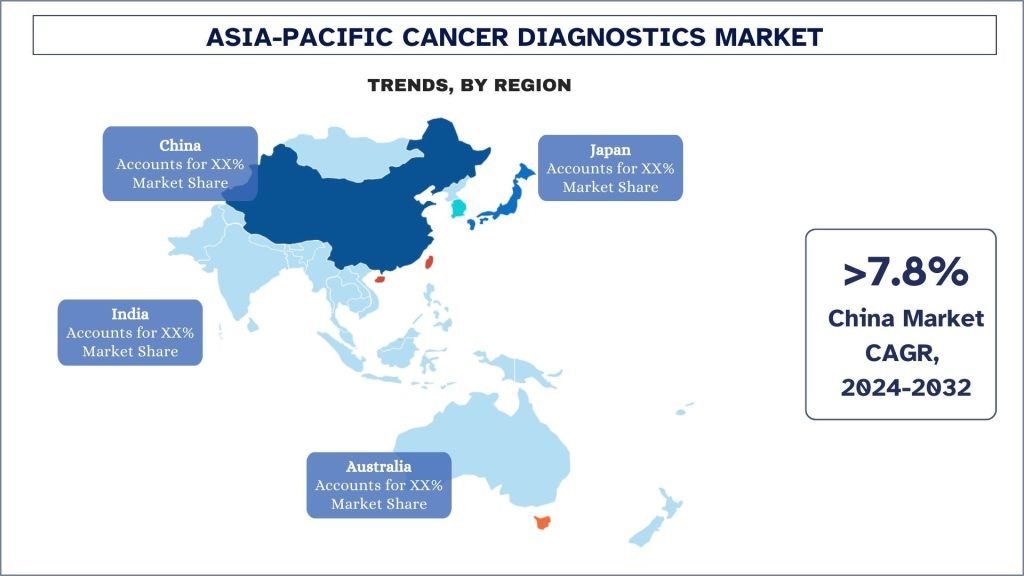
Asien-Pazifik Branchenüberblick für Krebsdiagnostik
Asien-Pazifik Krebsdiagnostik ist wettbewerbsfähig, mit mehreren asiatisch-pazifischen und internationalen Marktteilnehmern. Die wichtigsten Akteure verfolgen verschiedene Wachstumsstrategien, um ihre Marktpräsenz zu verbessern, wie z. B. Partnerschaften, Vereinbarungen, Kooperationen, neue Produkteinführungen, geografische Expansionen sowie Fusionen und Übernahmen. Einige der wichtigsten Akteure auf dem Markt sind F. Hoffmann-La Roche Ltd, BIOMÉRIEUX, Abbott, QIAGEN, Sysmex Asia Pacific Pte Ltd, Danaher Corporation, Siemens Healthineers AG, FUJIFILM Corporation, Illumina, Inc., Agilent Technologies, Inc.
Asien-Pazifik Marktnachrichten für Krebsdiagnostik
- Beispielsweise kündigte Roche am 9. September 2024 die Erweiterung seiner digitalen Pathologie Open Environment durch die Integration von mehr als 20 fortschrittlichen Algorithmen für künstliche Intelligenz (KI) von acht neuen Kooperationspartnern an. Diese strategischen Kooperationen zielen darauf ab, Pathologen und Wissenschaftler in der Krebsforschung und -diagnose durch die Nutzung modernster KI-Technologie zu unterstützen.
- Am 30. August 2023 gab die Sysmex Corporation bekannt, dass das OncoGuide NCC Oncopanel System (das „System“) in Japan nun durch die Krankenversicherung als Companion Diagnostic für Futibatinib abgedeckt ist, eine Behandlung für inoperables Gallengangskarzinom2 mit FGFR2-Genfusionen3, das nach einer Chemotherapie fortgeschritten ist.
Asien-Pazifik Marktabdeckung für Krebsdiagnostik
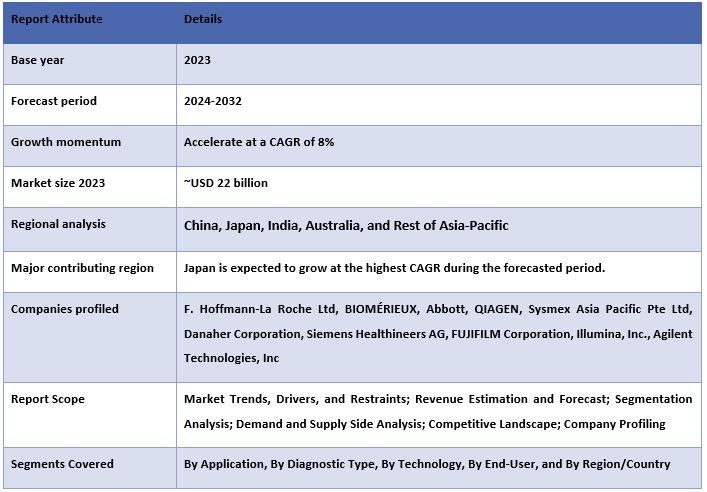
Gründe für den Kauf dieses Berichts:
- Die Studie umfasst eine Marktdimensionierungs- und Prognoseanalyse, die von authentifizierten wichtigen Branchenexperten validiert wurde.
- Der Bericht bietet einen schnellen Überblick über die Gesamtleistung der Branche auf einen Blick.
- Der Bericht enthält eine eingehende Analyse der wichtigsten Branchenkollegen mit einem primären Fokus auf wichtige Geschäftskennzahlen, Produktportfolios, Expansionsstrategien und die jüngsten Entwicklungen.
- Detaillierte Untersuchung der Treiber, Beschränkungen, wichtigsten Trends und Chancen, die in der Branche vorherrschen.
- Die Studie deckt den Markt umfassend über verschiedene Segmente hinweg ab.
- Tiefgehende regionale Analyse der Branche.
Anpassungsoptionen:
Asien-Pazifik Krebsdiagnostik kann weiter an die Anforderungen oder jedes andere Marktsegment angepasst werden. Darüber hinaus versteht UMI, dass Sie möglicherweise Ihre eigenen geschäftlichen Bedürfnisse haben. Zögern Sie daher nicht, sich mit uns in Verbindung zu setzen, um einen Bericht zu erhalten, der Ihren Anforderungen vollständig entspricht.
Inhaltsverzeichnis
Forschungsmethodik für die Asien-Pazifik Marktanalyse für Krebsdiagnostik (2022-2032)
Die Analyse des historischen Marktes, die Schätzung des aktuellen Marktes und die Prognose des zukünftigen Marktes des Asien-Pazifik-Marktes für Krebsdiagnostik waren die drei wichtigsten Schritte, die unternommen wurden, um die Akzeptanz von Asien-Pazifik-Krebsdiagnostik in den wichtigsten Regionen zu erstellen und zu analysieren. Es wurde eine umfassende Sekundärforschung durchgeführt, um die historischen Marktzahlen zu sammeln und die aktuelle Marktgröße zu schätzen. Zweitens wurden zahlreiche Erkenntnisse und Annahmen berücksichtigt, um diese Erkenntnisse zu validieren. Darüber hinaus wurden umfassende Primärinterviews mit Branchenexperten entlang der Wertschöpfungskette des Asien-Pazifik-Marktes für Krebsdiagnostik geführt. Nach der Annahme und Validierung der Marktzahlen durch Primärinterviews haben wir einen Top-Down-/Bottom-Up-Ansatz verwendet, um die vollständige Marktgröße zu prognostizieren. Anschließend wurden Marktaufschlüsselungs- und Datentriangulationsmethoden angewendet, um die Marktgröße von Segmenten und Untersegmenten der Branche zu schätzen und zu analysieren. Die detaillierte Methodik wird im Folgenden erläutert:
Analyse der historischen Marktgröße
Schritt 1: Eingehende Untersuchung sekundärer Quellen:
Es wurde eine detaillierte Sekundärstudie durchgeführt, um die historische Marktgröße des Asien-Pazifik-Marktes für Krebsdiagnostik durch unternehmensinterne Quellen wieJahresberichte und Finanzberichte, Performance-Präsentationen, Pressemitteilungen usw.,und externe Quellen einschließlichFachzeitschriften, Nachrichten und Artikel, Regierungsveröffentlichungen, Wettbewerbsveröffentlichungen, Branchenberichte, Datenbanken von Drittanbietern und andere glaubwürdige Veröffentlichungen.
Schritt 2: Marktsegmentierung:
Nachdem wir die historische Marktgröße der Asien-Pazifik-Krebsdiagnostik erhalten hatten, führten wir eine detaillierte Sekundäranalyse durch, um historische Markteinblicke und -anteile für verschiedene Segmente und Untersegmente für wichtige Regionen zu sammeln. Wichtige Segmente sind im Bericht enthalten, wie z. B. Anwendung, Diagnosetyp, Technologie, Endverbraucher und Land. Darüber hinaus wurden Länderanalysen durchgeführt, um die Gesamtakzeptanz von Testmodellen in dieser Region zu bewerten.
Schritt 3: Faktorenanalyse:
Nachdem wir die historische Marktgröße verschiedener Segmente und Untersegmente erfasst hatten, führten wir eine detaillierteFaktorenanalysedurch, um die aktuelle Marktgröße des Asien-Pazifik-Marktes für Krebsdiagnostik zu schätzen. Darüber hinaus führten wir eine Faktorenanalyse unter Verwendung abhängiger und unabhängiger Variablen wie Anwendung, Diagnosetyp, Technologie, Endverbraucher und Asien-Pazifik-Krebsdiagnostikregionen durch. Es wurde eine gründliche Analyse der Nachfrage- und Angebotsseitenszenarien unter Berücksichtigung der Top-Partnerschaften, Fusionen und Übernahmen, Geschäftserweiterungen und Produkteinführungen im Asien-Pazifik-Krebsdiagnostikmarktsektor auf der ganzen Welt durchgeführt.
Aktuelle Marktzielschätzung und Prognose
Aktuelle Marktgröße:Basierend auf umsetzbaren Erkenntnissen aus den obigen drei Schritten sind wir zur aktuellen Marktgröße, den wichtigsten Akteuren auf dem Markt für Krebsdiagnostik im asiatisch-pazifischen Raum und den Marktanteilen der Segmente gelangt. Alle erforderlichen prozentualen Anteile, Aufschlüsselungen und Marktunterteilungen wurden unter Verwendung des oben genannten sekundären Ansatzes ermittelt und durch Primärinterviews verifiziert.
Schätzung & Prognose:Für die Marktschätzung und -prognose wurden verschiedene Faktoren gewichtet, darunter Treiber & Trends, Einschränkungen und Chancen für die Stakeholder. Nach der Analyse dieser Faktoren wurden relevante Prognosetechniken, d.h. der Top-down-/Bottom-up-Ansatz, angewendet, um die Marktprognose für 2032 für verschiedene Segmente und Untersegmente in den wichtigsten Märkten zu erstellen. Die Forschungsmethodik zur Schätzung der Marktgröße umfasst:
- Die Marktgröße der Branche, gemessen am Umsatz (USD) und die Adoptionsrate der Krebsdiagnostik im asiatisch-pazifischen Raum in den wichtigsten Märkten im Inland
- Alle prozentualen Anteile, Aufteilungen und Aufschlüsselungen der Marktsegmente und -untersegmente
- Wichtige Akteure im Bereich Krebsdiagnostik im asiatisch-pazifischen Raum in Bezug auf die angebotenen Produkte. Außerdem die Wachstumsstrategien, die diese Akteure anwenden, um in dem schnell wachsenden Markt zu bestehen
Marktgrößen- und -anteilsvalidierung
Primärforschung:Es wurden eingehende Interviews mit den wichtigsten Meinungsführern (Key Opinion Leaders, KOLs) geführt, darunter Top-Level-Führungskräfte (CXO/VPs, Vertriebsleiter, Marketingleiter, Betriebsleiter, Regionalleiter, Landesleiter usw.) in den wichtigsten Regionen. Die Ergebnisse der Primärforschung wurden dann zusammengefasst und eine statistische Analyse durchgeführt, um die aufgestellte Hypothese zu belegen. Die Ergebnisse der Primärforschung wurden mit den Ergebnissen der Sekundärforschung konsolidiert, wodurch Informationen in umsetzbare Erkenntnisse umgewandelt wurden.
Aufschlüsselung der primären Teilnehmer in verschiedenen Regionen
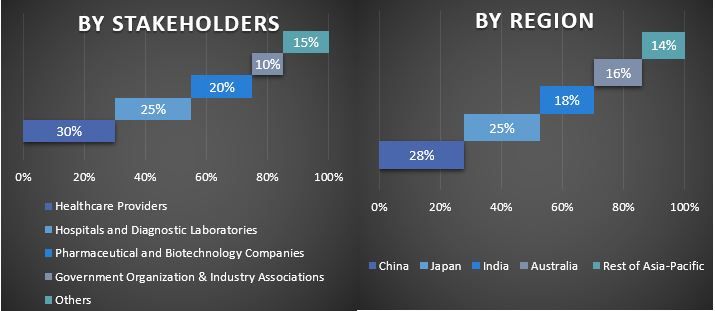
Markt-Engineering
Die Daten-Triangulationstechnik wurde eingesetzt, um die gesamte Marktschätzung abzuschließen und präzise statistische Zahlen für jedes Segment und Untersegment der Krebsdiagnostik im asiatisch-pazifischen Raum zu erhalten. Die Daten wurden in mehrere Segmente und Untersegmente aufgeteilt, nachdem verschiedene Parameter und Trends in Bezug auf Anwendung, Diagnosetyp, Technologie, Endverbraucher und Land des Marktes für Krebsdiagnostik im asiatisch-pazifischen Raum untersucht wurden.
Das Hauptziel der Marktstudie zur Krebsdiagnostik im asiatisch-pazifischen Raum
Die aktuellen und zukünftigen Markttrends der Krebsdiagnostik im asiatisch-pazifischen Raum wurden in der Studie herausgearbeitet. Investoren können strategische Erkenntnisse gewinnen, um ihre Investitionsentscheidungen auf der in der Studie durchgeführten qualitativen und quantitativen Analyse zu basieren. Aktuelle und zukünftige Markttrends bestimmten die allgemeine Attraktivität des Marktes auf regionaler Ebene und boten den Industrieakteuren eine Plattform, um den unerschlossenen Markt zu nutzen und von einem First-Mover-Vorteil zu profitieren. Weitere quantitative Ziele der Studien sind:
- Analysieren Sie die aktuelle und prognostizierte Marktgröße des Marktes für Krebsdiagnostik im asiatisch-pazifischen Raum in Bezug auf den Wert (USD). Analysieren Sie außerdem die aktuelle und prognostizierte Marktgröße verschiedener Segmente und Untersegmente.
- Die Segmente in der Studie umfassen Anwendungsbereiche, Diagnosetyp, Technologie, Endverbraucher und Land.
- Definieren und analysieren Sie den regulatorischen Rahmen für die Krebsdiagnostik im asiatisch-pazifischen Raum
- Analysieren Sie die Wertschöpfungskette mit dem Vorhandensein verschiedener Intermediäre sowie das Kunden- und Wettbewerbsverhalten der Branche.
- Analysieren Sie die aktuelle und prognostizierte Marktgröße des Marktes für Krebsdiagnostik im asiatisch-pazifischen Raum für die wichtigsten Regionen.
- Zu den wichtigsten in dem Bericht untersuchten Regionen gehören China, Japan, Indien, Australien und der Rest des asiatisch-pazifischen Raums
- Unternehmensprofile des Marktes für Krebsdiagnostik im asiatisch-pazifischen Raum und die Wachstumsstrategien, die von den Marktteilnehmern angewendet werden, um sich in dem schnell wachsenden Markt zu behaupten.
- Detaillierte Analyse der Branche auf regionaler Ebene
Häufig gestellte Fragen FAQs
Q1: Wie groß ist die aktuelle Größe und das Wachstumspotenzial der Krebsdiagnostik im asiatisch-pazifischen Raum?
Q2: Was sind die treibenden Faktoren für das Wachstum der Krebsdiagnostik im asiatisch-pazifischen Raum?
Q3: Welches Segment hat den größten Anteil an der Krebsdiagnostik im asiatisch-pazifischen Raum nach Anwendung?
Q4: Was sind die aufkommenden Technologien und Trends in der Krebsdiagnostik im asiatisch-pazifischen Raum?
Q5: Welche Region wird den Markt für Krebsdiagnostik im asiatisch-pazifischen Raum dominieren?
Verwandt Berichte
Kunden, die diesen Artikel gekauft haben, kauften auch

